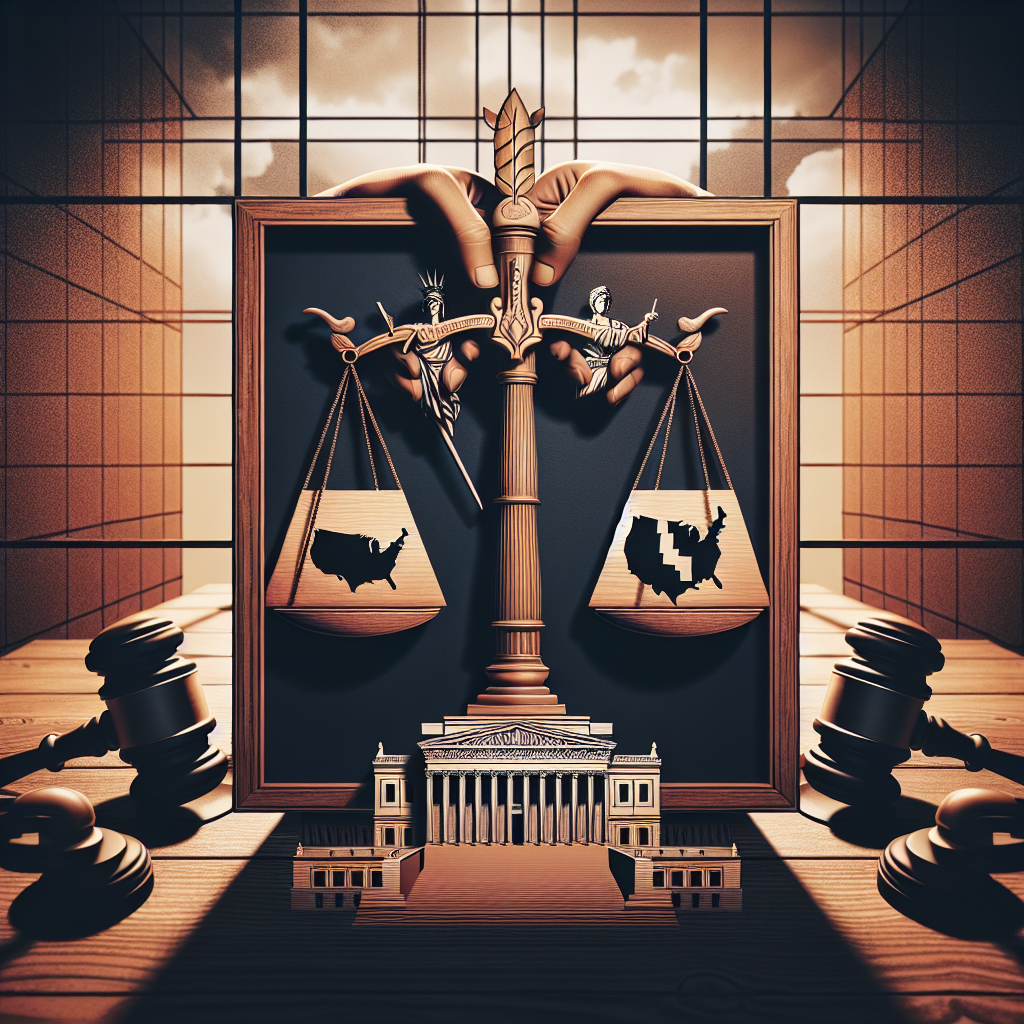Supreme Court Decision Sparks Debate Over State Rights
The recent Supreme Court decision in 2025 has ignited a firestorm of debate across the nation regarding states’ rights. As justices leaned toward empowering states in key legal battles, political parties, advocacy groups, and citizens alike speculated about the implications for federalism and individual liberties. The ruling set the stage for a renewed examination of the powers allocated to states versus the federal government, posing significant questions about governance and the balance of power. In an era defined by polarization and political maneuvering, the discussions stemming from this decision are critical for understanding the future of American democracy.
The Key Supreme Court Decision and Its Context
On January 15, 2025, the Supreme Court delivered a significant ruling in State of Nebraska v. Federal Government, which involved contentious issues such as healthcare regulations and environmental policies. This landmark decision marked a departure from previous court rulings that typically favored federal authority, thereby sparking a paradigm shift in the conversation surrounding states’ rights. Justices ruled that the Constitution’s Tenth Amendment, which underscores states’ rights, was to be interpreted more liberally, allowing states greater autonomy in regulating issues that intersect with federal law.
The ruling emerged from ongoing tensions between state and federal governments, particularly regarding regulations related to public health and environmental sustainability. Proponents of states’ rights hailed the decision as a victory for local governance and citizen engagement, arguing it empowers states to tailor policies to better fit the needs of their populations. In contrast, critics voice concerns that this devolution of power could lead to a patchwork of laws that hinder the ability to address nationwide issues effectively, such as climate change and public health crises.
Historical Context of States’ Rights
To fully grasp the implications of the recent Supreme Court decision, it’s essential to understand the historical context surrounding states’ rights in the United States. The concept has been a central tension in American political life since the founding of the republic, revolving around the delicate balance of power between the federal government and individual states. Historically, the civil rights movement exemplified the struggle for state autonomy versus federal oversight, as states often enacted laws that contradicted federal mandates aimed at promoting equality and eliminating discrimination.
The evolution of states’ rights further crystalized during critical moments in U.S. history, as seen during debates over the New Deal, civil rights legislation, and more recently, healthcare reform. These historical precedents set a powerful stage for contemporary battles over legal jurisdiction and individual liberties. With the courts frequently acting as arbiters in these conflicts, the latest Supreme Court decision signals a potential revival of states’ rights, urging lawmakers, regulators, and citizens to take a renewed interest in the crucial interplay between state and federal governance.
Reactions from Political Leaders and Advocacy Groups
The Supreme Court’s decision reverberated throughout political spheres, eliciting passionate responses along partisan lines. Republican leaders largely celebrated the ruling as a restoration of conceptual freedoms for states, expressing hopes that it might inspire further legislative initiatives aimed at decentralizing authority from the federal government. Some state governors have already indicated their intent to expand their regulatory powers in areas previously dominated by federal mandates, likely fuelled by the Supreme Court’s endorsement of states’ rights.
Conversely, many Democratic leaders and progressive advocacy groups condemned the ruling, fearing that it could lead to regression in civil rights and protections. They argue that such devolutions of power may allow states to impose more stringent laws that could discriminate against vulnerable populations, especially in areas related to healthcare access, environmental protections, and social justice issues. The overarching apprehension underscores the complexity surrounding the states’ rights debate, revealing the multitude of voices that contribute to shaping the policy landscape.
Potential Impacts on Citizens and Local Governance
As states reclaim regulatory powers, individual citizens may experience both the advantages and disadvantages of this shift. On one hand, a greater emphasis on states’ rights could empower local communities to innovate solutions tailored to their unique needs. For instance, states might prioritize localized healthcare initiatives, educational reforms, and environmental sustainability practices that resonate more closely with their constituents’ values and concerns. This localized governance could foster a sense of community accountability and responsiveness in a political landscape often dominated by federal one-size-fits-all approaches.
However, the flip side of such empowerment represents noticeable risks. With this power shift, the likelihood of various inequities becoming more pronounced increases, as disparities in resources and priorities may lead to significant inconsistencies across state lines. A state that opts to downscale environmental regulations or limit healthcare access could adversely affect its residents, especially marginalized groups. Ensuring that states uphold the rights and protections afforded to all citizens becomes an essential challenge, emphasizing the need for oversight and vigilance during this historical evolution in governance.
The Future Landscape of Federalism in America
As the 2025 Supreme Court decision solidifies a renewed focus on states’ rights, the future of federalism in America appears poised for significant transformation. Legal scholars predict that we will see a rise in litigation surrounding the balance of state versus federal authority, with both sides of the debate scrutinizing the limits of jurisdiction over key issues such as immigration, healthcare, and climate policy. Innovations in state governance may emerge as laboratories of democracy, providing experimental solutions to current problems—yet these experiments may come at the cost of consistency and equality across the nation.
Moreover, the role of public sentiment will be crucial in shaping the ongoing debate over states’ rights. Citizens increasingly engaged with policymaking decisions—fueled by grassroots movements and digital activism—could wield greater influence over their state legislatures. Alternatively, public engagement may wane in the face of growing political divisions and polarization. Advocacy groups will need to rally support effectively while ensuring they communicate the implications of states’ rights in an accessible manner to the average citizen.
The overarching question remains: How will these evolving power dynamics influence future generations? With the discourse surrounding civil rights, healthcare, and environmental policies at a critical juncture, it is likely that states’ rights will continue to feature prominently in the legal and political conversations of the years ahead. As such, the implications of this ruling are likely to reverberate through American society, prompting demands for legislative reforms, state action, and vigilant engagement by the citizenry.
Conclusion
In conclusion, the Supreme Court’s decision in 2025 to lean toward states’ rights has triggered a compelling debate that touches the very foundations of American governance. By exploring historical precedents, political reactions, and potential impacts on citizens, we can appreciate the complex interplay between state and federal authority. The ruling signifies a turning point in the ongoing struggle for power and autonomy, igniting discussions that will shape the legal and political landscape for years to come. As states navigate their newfound authority, the commitment to protecting the rights of all citizens will be a vital benchmark for evaluating the success and sustainability of this transformative moment in American democracy.
FAQs
What was the Supreme Court’s decision regarding states’ rights in 2025?
The Supreme Court ruled in *State of Nebraska v. Federal Government*, emphasizing the Tenth Amendment and granting states greater autonomy in regulating areas traditionally governed by federal law.
How do states’ rights impact individual citizens?
States’ rights can empower local governance to address unique community needs; however, they may also lead to disparities in protections and rights for individuals, especially among marginalized groups.
What historical context is important for understanding states’ rights?
The concept of states’ rights has been a longstanding tension in U.S. history, prominent during civil rights movements and key political debates over federal authority versus local governance.
What are political leaders saying about the ruling?
Republicans have welcomed the decision as a win for states’ rights, while Democrats have expressed concerns that it may regress civil rights and protections.
What could be the future implications of this ruling?
This ruling could lead to increased litigation regarding federal and state authority while prompting diverse policy innovations at the state level, potentially resulting in significant variations in governance across the nation.












